
Spring Semester, 2005
Coupling
© 2005, All Rights Reserved, SDSU & Roger Whitney
San Diego State University -- This page last updated 23-Feb-05

|
Advanced Object-Oriented Design & Programming
Spring Semester, 2005 Coupling |
|
|---|---|---|
|
© 2005, All Rights Reserved, SDSU & Roger Whitney San Diego State University -- This page last updated 23-Feb-05 |
Different Ways to Implement Uses
Heuristics for the Uses Relationship
Inside Internal Object Coupling
Outside Internal Coupling from Underneath
Outside Internal Coupling from the Side
Copyright ©, All rights reserved. 2005 SDSU & Roger Whitney, 5500 Campanile Drive, San Diego, CA 92182-7700 USA. OpenContent ( http://www.opencontent.org/opl.shtml) license defines the copyright on this document.
| CS 635 Spring 05 | Doc 8, Coupling Slide # 2 |
Object Coupling and Object Cohesion, chapter 7 of Essays on Object-Oriented Software Engineering , Vol. 1, Berard, Prentice-Hall, 1993
Object-Oriented Design Heuristics, Riel, Addison-Wesley, 1996
On the Criteria To Be Used in Decomposing Systems into Modules, D. L. Parnas, http://www.acm.org/classics/may96/
Object Coupling and Object Cohesion. pp. 72-86, 92-111
| CS 635 Spring 05 | Doc 8, Coupling Slide # 3 |
Decomposing systems into smaller pieces aids software development
100 functions each 100 line of code long is "better" than One function 10,000 lines of code long
| CS 635 Spring 05 | Doc 8, Coupling Slide # 4 |
Parnas compared two different implementations
Write down in order list of high-level tasks to be done
Each high level task becomes a module (function)
List
Each module should hide a design decision
All ways of decomposing an application are not equal
| CS 635 Spring 05 | Doc 8, Coupling Slide # 5 |
Primary goal of decomposition into modules is reduction of software cost
Specific goals of module decomposition
| CS 635 Spring 05 | Doc 8, Coupling Slide # 6 |
Coupling
Cohesion
| CS 635 Spring 05 | Doc 8, Coupling Slide # 7 |
Type of Relations:
|
Type |
Relation between |
|
Uses |
(Object) |
|
Containment |
(Object) |
|
Inheritance |
(Class) |
|
Association |
(Object) |
Uses
Containment
| CS 635 Spring 05 | Doc 8, Coupling Slide # 8 |
How does the sender access the receiver?
1. Containment
class Sender {
Receiver here;
public void method() {
here.sendAMessage();
}
}
2. Argument of a method
class Sender {
public void method(Receiver here) {
here.sendAMessage();
}
}
| CS 635 Spring 05 | Doc 8, Coupling Slide # 9 |
3. Ask someone else
class Sender {
public void method() {
Receiver here = someoneElse.getReceiver();
here.sendAMessage();
}
}
4. Creation
class Sender {
public void method() {
Receiver here = new Receiver();
here.sendAMessage();
}
}
5. Global
| CS 635 Spring 05 | Doc 8, Coupling Slide # 10 |
4.1 Minimize the number of classes with another class collaborates
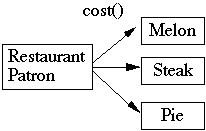
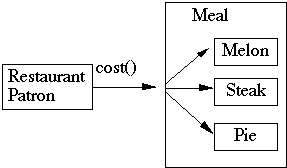
| CS 635 Spring 05 | Doc 8, Coupling Slide # 11 |
4.2 Minimize the number of message sends between a class and its collaborator
4.3 Minimize the number of different messages a class sends to another class.
4.4 Minimize the product of the number of methods in a class and the number of different messages they send.
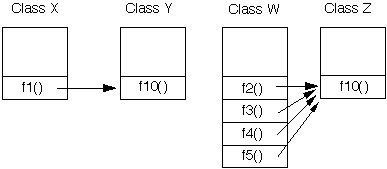


| CS 635 Spring 05 | Doc 8, Coupling Slide # 12 |
Decomposable system
A nearly decomposable system
Design Goal
| CS 635 Spring 05 | Doc 8, Coupling Slide # 13 |
Measure of the interdependence among modules
"Unnecessary object coupling needlessly decreases the reusability of the coupled objects "
"Unnecessary object coupling also increases the chances of system corruption when changes are made to one or more of the coupled objects"
| CS 635 Spring 05 | Doc 8, Coupling Slide # 14 |
Data Coupling
(weakest – most desirable)Control Coupling
Global Data Coupling
Internal Data Coupling
(strongest – least desirable)Content Coupling
(Unrated)| CS 635 Spring 05 | Doc 8, Coupling Slide # 15 |
Output from one module is the input to another
Using parameter lists to pass items between routines
Common Object Occurrence:
Object A passes object X to object B Object X and B are coupled A change to X's interface may require a change to B
Example
class ObjectBClass{
public void message( ObjectXClass X ){
// code goes here
X.doSomethingForMe( Object data );
// more code
}
}
| CS 635 Spring 05 | Doc 8, Coupling Slide # 16 |
Major Problem
Object A passes object X to object B X is a compound object Object B must extract component object Y out of X B, X, internal representation of X, and Y are coupled
public class HiddenCoupling {
public bar someMethod(SomeType x) {
AnotherType y = x.getY();
y.foo();
blah;
}
}
| CS 635 Spring 05 | Doc 8, Coupling Slide # 17 |
Example: Sorting student records, by ID, by Name
How does the SortedList method add() add the new student record object and resort the list? To do this it needs to access the ID (name) fields of StudentRecord!
class StudentRecord {
Name lastName;
Name firstName;
long ID;
public Name getLastName() { return lastName; }
// etc.
}
SortedList cs535 = new SortedList();
StudentRecord newStudent;
//etc.
cs535.add ( newStudent );
| CS 635 Spring 05 | Doc 8, Coupling Slide # 18 |
Solution 1 Bad News
Here the add method actually accesses the StudentRecord method to get the ID. What is wrong with that? Why is this bad news?
class SortedList
{
Object[] sortedElements = new Object[ properSize ];
public void add( StudentRecord X )
{
// coded not shown
Name a = X.getLastName();
Name b = sortedElements[ K ].getLastName();
if ( a.lessThan( b ) )
// do something
else
// do something else
}
}
SortList>>add: aStudentRecord
Blah
a := aStudentRecord lastName.
b := sortedElements at: k.
blah
| CS 635 Spring 05 | Doc 8, Coupling Slide # 19 |
Solution 2 Send message to object to compare self to another StudentRecord Object
How is this any better that solution 1? Is it any better? How does it differ?
class SortedList{
Object[] sortedElements = new Object[ properSize ];
public void add( StudentRecord X ) {
// coded not shown
if ( X.lessthan( sortedElements[ K ] ) )
// do something
else
// do something else
}
}
class StudentRecord{
private Name lastName;
private long ID;
public boolean lessThan( Object compareMe ) {
return lastName.lessThan( compareMe.lastName );
}
etc.
}
SortList>>add: aStudentRecord
Blah
aStudentRecord < sortedElements last
ifTrue: [ more blah ]
ifFalse: [ blah blah ]
blah
| CS 635 Spring 05 | Doc 8, Coupling Slide # 20 |
Solution 3 Program to an Interface or "required operations"
Notice how the SortedList is no longer coupled to the StudentRecord class. It can be used to sort any list of objects of the same class than implement Comparable.
interface Comparable {
public boolean lessThan( Object compareMe );
public boolean greaterThan( Object compareMe );
public boolean equal( Object compareMe );
}
class StudentRecord implements Comparable {
private Name lastName;
private long ID;
public boolean lessThan( Object compareMe ) {
return lastName.lessThan( ((Name)compareMe).lastName );
}
}
class SortedList {
Object[] sortedElements = new Object[ properSize ];
public void add( Comparable X ) {
// coded not shown
if ( X.lessthan( sortedElements[ K ] )
// do something
else
// do something else
}
}
SortList>>add: anObject
anObject < sortedElements last
ifTrue: [ more blah ]
ifFalse: [ blah blah ]
blah
| CS 635 Spring 05 | Doc 8, Coupling Slide # 21 |
Solution 4 Strategy Pattern & Blocks
| sortedStudents |
sortedStudents := SortedCollection sortBlock:
[:x :y | x lastName < y lastName].
blah
sortedStudents
add: roger;
add: pete;
add: sam.
sortedStudents sortBlock: [:x :y | x grade < y grade ]
| CS 635 Spring 05 | Doc 8, Coupling Slide # 22 |
Solution 4 Strategy Pattern & Function Pointers
Code is neither legal C/C++ nor Java. The idea is to pass in a function pointer to the SortList object, which it uses to compare the objects in the list.
typedef int (*compareFun ) ( StudentRecord, StudentRecord );
class SortedList {
StudentRecord[] sortedElements =
new StudentRecord[ properSize ];
int (*compare ) ( StudentRecord, StudentRecord );
public setCompare( compairFun newCompare )
{ compare = newCompare; }
public void add( StudentRecord X ) {
// coded not shown
if ( compare( X, sortedElements[ K ] ) )
// code not shown
}
}
int compareID( StudentRecord a, StudentRecord b )
{ // code not shown }
int compareName( StudentRecord a, StudentRecord b )
{ // code not shown }
SortedList myList = new SortedList();
myList.setCompair( compareID );
| CS 635 Spring 05 | Doc 8, Coupling Slide # 23 |
Functors are functions that behave like objects
They serve the role of a function, but can be created, passed as parameters, and manipulated like objects
A functor is a class with a single member function
Note 1: Functors violate the idea that a class is an abstraction with operations and state. Beginners should avoid using the Functor pattern, as they can lead to bad habits. The functor pattern is used here only as a last resort. Note 2: The Command pattern is similar to the Functor pattern, but contains operations and state.
| CS 635 Spring 05 | Doc 8, Coupling Slide # 24 |
In Java 2, the Comparator interface defines an interface for objects that act like functions pointers to compare objects.
int compare(Object o1, Object o2)
Returns a negative integer, zero, or a positive integer as the first argument is less than, equal to, or greater than the second
boolean equals(Object obj)
Indicates whether some other object is "equal to" this Comparator.
The implementer must ensure that:
sgn(compare(x, y)) == -sgn(compare(y, x)) for all x and y
compare(x, y) must throw an exception if and only if compare(y, x) throws an exception.)
((compare(x, y)>0) && (compare(y, z)>0)) implies compare(x, z)>0.
x.equals(y) || (x==null && y==null) implies that compare(x, y)==0.
compare(x, y)==0 implies that sgn(compare(x, z))==sgn(compare(y, z)) for all z.
| CS 635 Spring 05 | Doc 8, Coupling Slide # 25 |
import java.util. Comparator;
class Student {
String name;
int id;
public Student( String newName, int id ) {
name = newName;
this.id = id;
}
public String toString() {
return name + ":" + id;
}
}
final class StudentNameComparator implements Comparator {
public int compare( Object leftOp, Object rightOp ) {
String leftName = ((Student) leftOp).name;
String rightName = ((Student) rightOp).name;
return leftName.compareTo( rightName );
}
public boolean equals( Object comparator ) {
return comparator instanceof StudentNameComparator;
}
}
| CS 635 Spring 05 | Doc 8, Coupling Slide # 26 |
final class StudentIdComparator implements Comparator {
static final int LESS_THAN = -1;
static final int GREATER_THAN = 1;
static final int EQUAL = 0;
public int compare( Object leftOp, Object rightOp ) {
long leftId = ((Student) leftOp).id;
long rightId = ((Student) rightOp).id;
if ( leftId < rightId )
return LESS_THAN;
else if ( leftId > rightId )
return GREATER_THAN;
else
return EQUAL;
}
public boolean equals( Object comparator ) {
return comparator instanceof StudentIdComparator;
}
}
| CS 635 Spring 05 | Doc 8, Coupling Slide # 27 |
import java.util.*;
public class Test {
public static void main(String args[]) {
Student[] cs596 = { new Student( "Li", 1 ), new Student( "Swen", 2 ),
new Student( "Chan", 3 ) };
//Sort the array
Arrays.sort( cs596, new StudentNameComparator() );
for ( int k = 0; k < cs596.length; k++ )
System.out.print( cs596[k].toString() + ", " );
System.out.println( );
List cs596List = new ArrayList( );
cs596List.add( new Student( "Li", 1 ) );
cs596List.add( new Student( "Swen", 2 ) );
cs596List.add( new Student( "Chan", 3 ) );
System.out.println( "Unsorted list " + cs596List );
//Sort the list
Collections.sort( cs596List, new StudentNameComparator() );
System.out.println( "Sorted list " + cs596List );
//TreeSets are aways sorted
TreeSet cs596Set = new TreeSet( new StudentNameComparator() );
cs596Set.add( new Student( "Li", 1 ) );
cs596Set.add( new Student( "Swen", 2 ) );
cs596Set.add( new Student( "Chan", 3 ) );
System.out.println( "Sorted Set " + cs596Set );
}
}
| CS 635 Spring 05 | Doc 8, Coupling Slide # 28 |
Chan:3, Li:1, Swen:2, Unsorted list [Li:1, Swen:2, Chan:3] Sorted list [Chan:3, Li:1, Swen:2] Sorted Set [Chan:3, Li:1, Swen:2]
| CS 635 Spring 05 | Doc 8, Coupling Slide # 29 |
import java.util.*;
public class MultipleSorts {
public static void main(String args[]) {
List cs596List = new ArrayList( );
cs596List.add( new Student( "Li", 1 ) );
cs596List.add( new Student( "Swen", 2 ) );
cs596List.add( new Student( "Chan", 3 ) );
Collections.sort( cs596List, new StudentNameComparator() );
System.out.println( "Name Sorted list " + cs596List );
Collections.sort( cs596List, new StudentIdComparator() );
System.out.println( "Id Sorted list " + cs596List );
TreeSet cs596Set = new TreeSet( new StudentNameComparator());
cs596Set.addAll( cs596List );
System.out.println( "Name Sorted Set " + cs596Set );
TreeSet cs596IdSet = new TreeSet( new StudentIdComparator() );
cs596IdSet.addAll( cs596List );
System.out.println( "Id Sorted Set " + cs596IdSet );
}
}
Name Sorted list [Chan:1, Li:2, Swen:1] Id Sorted list [Chan:1, Swen:1, Li:2] Name Sorted Set [Chan:1, Li:2, Swen:1] Id Sorted Set [Chan:1, Li:2]
| CS 635 Spring 05 | Doc 8, Coupling Slide # 30 |
Passing control flags between modules so that one module controls the sequencing of the processing steps in another module
Common Object Occurrences:
A sends a message to B B uses a parameter of the message to decide what to do
class Lamp {
public static final ON = 0;
public void setLamp( int setting ) {
if ( setting == ON )
//turn light on
else if ( setting == 1 )
// turn light off
else if ( setting == 2 )
// blink
}
}
Lamp reading = new Lamp();
reading.setLamp( Lamp.ON );
reading.setLamp)( 2 );
| CS 635 Spring 05 | Doc 8, Coupling Slide # 31 |
Cure:
Decompose the operation into multiple primitive operations
class Lamp {
public void on() {//turn light on }
public void off() {//turn light off }
public void blink() {//blink }
}
Lamp reading = new Lamp();
reading.on();
reading.blink();
| CS 635 Spring 05 | Doc 8, Coupling Slide # 32 |
BankAccount>>withdrawal: aFloat balance := balance – aFloat.
BankAccount>>withdrawal: aFloat
balance < aFloat
ifTrue: [ self bounceThisCheck ]
ifFalse: [balance := balance – aFloat]
| CS 635 Spring 05 | Doc 8, Coupling Slide # 33 |
Common Object Occurrences:
Example: Returning error codes
class Test {
public int printFile( File toPrint ) {
if ( toPrint is corrupted )
return CORRUPTFLAG;
blah blah blah
}
}
Test when = new Test();
int result = when.printFile( popQuiz );
if ( result == CORRUPTFLAG )
blah
else if ( result == -243 )
| CS 635 Spring 05 | Doc 8, Coupling Slide # 34 |
Cure: Use exceptions
How does this reduce coupling?
class Test {
public int printFile( File toPrint ) throws PrintExeception {
if ( toPrint is corrupted )
throws new PrintExeception();
blah blah blah
}
}
try {
Test when = new Test();
when.printFile( popQuiz );
}
catch ( PrintException printError ) {
do something
}
| CS 635 Spring 05 | Doc 8, Coupling Slide # 35 |
Two or more modules share the same global data structures
Common Object Occurrence :
A method in one object makes a specific reference to a specific external object
A method in one object makes a specific reference to a specific external object, and to one or more specific methods in the interface to that external object
A component of an object-oriented system has a public interface which consists of items whose values remain constant throughout execution, and whose underlying structures/implementations are hidden
A component of an object-oriented system has a public interface which consists of items whose values remain constant throughout execution, and whose underlying structures/implementations are not hidden
A component of an object-oriented system has a public interface which consists of items whose values do not remain constant throughout execution, and whose underlying structures/implementations are hidden
A component of an object-oriented system has a public interface which consists of items whose values do not remain constant throughout execution, and whose underlying structures/implementations are not hidden
| CS 635 Spring 05 | Doc 8, Coupling Slide # 36 |
One module directly modifies local data of another module
Common Object Occurrence:
C++ Friends
A friend of a class in C++ has complete access to all private members of the class. This is a clear violation of the information hiding feature of the class. Since the class must list its friends, the violation is controlled. There are situations (defining the io operators <<, >>) where the use of friends can not be avoided
| CS 635 Spring 05 | Doc 8, Coupling Slide # 37 |
Some or all of the contents of one module are included in the contents of another
Common Object Occurrence :
C/C++ header files
Decrease coupling by:
Restrict what goes in header file C++ header files should contain only class interface specifications
| CS 635 Spring 05 | Doc 8, Coupling Slide # 38 |
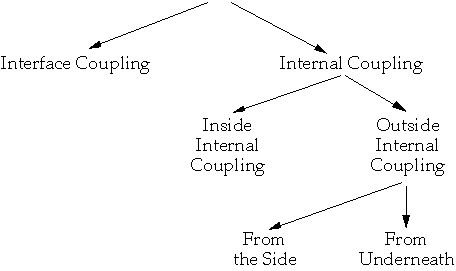
Very little is written about object coupling. For more information see “Managing Class Coupling: Apply the Principles of Structured Design to Object-Oriented Programming,” UNIX Review, Vol. 2, No. 1, May/June 1989, pp. 34-40.
Coupling measures the strength of the physical relationships among the items that comprise an object
Cohesion measures the logical relationship among the items that comprise an object
Interface coupling is the coupling between an object and all objects external to it. Interface coupling is the most desirable form of object coupling. Internal coupling is coupling among the items that make up an object.
| CS 635 Spring 05 | Doc 8, Coupling Slide # 39 |
Interface coupling occurs when one object refers to another specific object, and the original object makes direct references to one or more items in the specific object's public interface
Includes module coupling already covered
Weakest form of object coupling, but has wide variation
Sub-topics
Object abstraction decoupling Selector decoupling Constructor decoupling Iterator decoupling
| CS 635 Spring 05 | Doc 8, Coupling Slide # 40 |
Assumptions that one object makes about a category of other objects are isolated and used as parameters to instantiate the original object.
Example: List items
C++ templates and Ada’s generics are the constructs Berard is talking about. Making the LinkedListCell a template removes any type specific code from the LinkedListCell class. This helps insure that the class can hold any type.
class LinkedListCell {
int cellItem;
LinkedListCell* next;
// code can now use fact that cellItem is an int
if ( cellItem == 5 ) print( "We Win" );
}
template <class type>
class LinkedListCell#2 {
type cellItem;
LinkedListCell* next;
// code does not know the type, it is just a cell item,
// it becomes an abstraction
}
| CS 635 Spring 05 | Doc 8, Coupling Slide # 41 |
Object Abstraction Decoupling Java does not support templates. Instead it supports Object as a root type. Using an Object as a type in the LinkedListCell class has some of the decoupling that Ada generics or C++ templates achieve. However, it provides only one category of objects (all of them). This solution that Smalltalk (with no compile time type checking) also supports. Java interfaces can be used to achieve decoupling in the same situations as Ada generics or C++ templates.
class LinkedListCellA {
int cellItem;
LinkedListCell next;
if ( cellItem == 5 ) print( "We Win" );
}
class LinkedListCellB {
Object cellItem;
LinkedListCell next;
if ( cellItem.operation1() ) print( "We Win" );
}
| CS 635 Spring 05 | Doc 8, Coupling Slide # 42 |
Example:
Counter object
class Counter{
int count = 0;
public void increment() { count++; }
public void reset() { count = 0; }
public void display() {
code to display the counter in a slider bar
}
Display of Counter
![]()
"display" couples the counter object to a particular output type
The counter class can not be used in other setting due to this coupling
Better Counter Class
class Counter{
int count = 0;
public void increment() { count++; }
public void reset() { count = 0; }
public int count() {return count;}
public String toString() {return String.valueOf( count );}
}
| CS 635 Spring 05 | Doc 8, Coupling Slide # 43 |
A primitive method is any method that cannot be implemented simply, efficiently, and reliably without knowledge of the underlying implementation of the object
Primitive methods are:
Functionally cohesive, they perform a single specific function Small, seldom exceed five "lines of code"
A composite method is any method constructed from two or more primitive methods – sometimes from different objects
Types of Primitive Operations
Selectors (get operations) Constructors (not the same as class constructors) Iterators
| CS 635 Spring 05 | Doc 8, Coupling Slide # 44 |
Selectors are encapsulated operations which return state information about their encapsulated object and do not alter the state of their encapsulated object
Replacing
public void display() {
code to display the counter
}
with
public String toString() {return String.valueOf( count );}
is an example of Selector decoupling.
By replacing a composite method (display) with a primitive method the Counter class is decoupled from the display device
This makes the Counter class far more useful
It also moves the responsibility of displaying the counter elsewhere
| CS 635 Spring 05 | Doc 8, Coupling Slide # 45 |
Operations that construct a new, or altered version of an object
Java and C++ both have language constructs called constructors. Berard has in mind a larger class of operations than those. Often static methods are used as constructors to create new objects. Berard’s example illustrating constructor decoupling is extremely vague. The fromString method below does make it clear what type of parameter is needed to create a new calendar object. One point to learn from his discussion is the desirability to have well defined interface to creating objects from primitive objects.
class Calendar {
public void getMonth( from where, or what) { blah }
}
class Calendar {
public static Calendar fromString( String date ) { blah}
}
| CS 635 Spring 05 | Doc 8, Coupling Slide # 46 |
Primitive objects are objects that are both:
This can include standard libraries and standard environments
That is any object that is known in any part of any application created using the implementation language
Primitive objects don't count in coupling with other objects
"An object that refers to itself and to primitive objects is considered for all intents and purposes, totally decoupled from other objects "
The motivation here is that primitive objects are very stable, that is will not change. If they do not change, then we do not have to be concerned about coupling with them. One reason to reduce coupling is to make it easier to deal with changes. A second reason to reduce coupling is to improve reuse. If class A uses class B, which is universally available to all programs using the language, then class A’s reusability is not affected by using class B. Berard’s argument has two problems. First, standard libraries do change over time. Look at the number of deprecated methods in the Java API. Of course, the Java API is very young. As the language ages, its core API should be more stable. The second problem is one can delude oneself about a company’s or personal class library as being “standard” and stable (and hence primitive) when they are not.
| CS 635 Spring 05 | Doc 8, Coupling Slide # 47 |
Object conceptually composed of two or more objects
Object conceptually composed from objects which are not all conceptually the same
The date class below is composed of three items that are the same type: ints. However, these ints represent different conceptual entities.
class Date{
int year;
int month;
int day;
}
Object conceptually composed from objects which are all conceptually the same
list of names - each item is a member of the same general category of object – a name
Berard’s homogeneous composite objects are basically container objects.
| CS 635 Spring 05 | Doc 8, Coupling Slide # 48 |
Allows the user to visit all the nodes in a homogeneous composite object and to perform some user-supplied operation at each node
Both Java and C++ support iterators
| CS 635 Spring 05 | Doc 8, Coupling Slide # 49 |
Using iterators reduces coupling by hiding the details of traversing through elements of a collection. If one used the non-iterator method of accessing the elements of collections, it becomes a lot of work to replace the use of one collection with another. One might want to replace an array with a binary search tree for better performance.
int[] list for (int k = 0; k < list.length; k ++ ) System.out.println( list[k] );
Vector list for (int k =0; k < list.size(); k++ ) Sytem.out.println( list.elementAt( k ) );
BinarySeachTree list
Node current = list.root();
Stack previous = new Stack();
Previous.push( current );
while (current != null )
{
a lot of code here
}
CS 635 Spring 05 Doc 8, Coupling Slide # 50
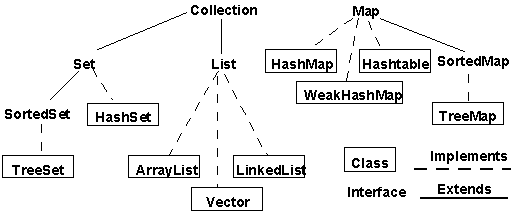
There are synchronized, unsynchronized, modifiable unmodifiable versions of each collection/map
One can set the modifiable and synchronized property separately
| CS 635 Spring 05 | Doc 8, Coupling Slide # 51 |
One of Java's defects is not making an Array class and making it part of the collection class hierarchy. As a result one has to treat arrays differently from all other collections. Since arrays are very common, the effectiveness of the collection class hierarchy is greatly lessened. However, since most programmers have not used a uniform collection class structure they do not realize how much easier life can be.
One can convert an array of objects to a list
String[] example = new String[10]; List listBackedByArray = Arrays.asList( example );
Changes to the array(list) are reflected in the list(array)
| CS 635 Spring 05 | Doc 8, Coupling Slide # 52 |
Collection list;
Iterator elements = list.iterator();
while (elements.hasNext() ) {
System.out.println( elements.next() );
}
In this code list could be any type of collection, so is more flexible. It is not coupled to a particular type of collection.
CS 635 Spring 05 Doc 8, Coupling Slide # 53
Coupling between state and operations of an object
Changing the structure of the state of an object requires changing all operations that access the state including operations in subclasses
Solution: Access state via access operations
C++ implementation
Simple Cases:
One function to access the value of the date member One function to change the value of the data member Only these two functions can access the data member
When an object is used as state, then providing access methods for that object can be far more complex. Assume that the state object itself has 10 methods. Now we may need to provide 12 access methods not just two. If a class have three such state objects, then it may need far too many access methods to be practical.
| CS 635 Spring 05 | Doc 8, Coupling Slide # 54 |
class Counter{
public:
void increment(void);
private:
int value;
void setValue(int newValue);
int getValue(void);
};
void Counter::increment(void) //Increase counter by one {
setValue(getValue() + 1);
};
void Counter::setValue(int newValue) {
value = newValue;
};
int Counter::getValue {
return value;
};
| CS 635 Spring 05 | Doc 8, Coupling Slide # 55 |
Coupling between a class and subclass involving private state and private operations
Major Issues:
Direct access to inherited state
See inside internal object coupling
Access via operations
Inherited operations may not be sufficient set of operations to access state for subclass
Parent class may have operations and state not needed by subclass
Unwanted inheritance makes the subclass unnecessarily complex. This reduces understandability and reliability.
| CS 635 Spring 05 | Doc 8, Coupling Slide # 56 |
Class A accesses private state or private operations of class B
Class A and B are not related via inheritance
Main causes:
Using nonobject-oriented languages Special language "features" C++ friends
Donald Knuth
Copyright ©, All rights reserved.
2005 SDSU & Roger Whitney, 5500 Campanile Drive, San Diego, CA 92182-7700 USA.
OpenContent license defines the copyright on this document.